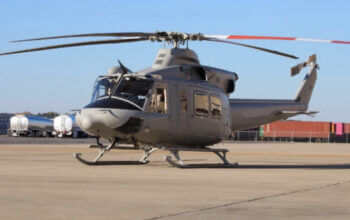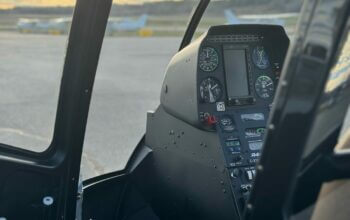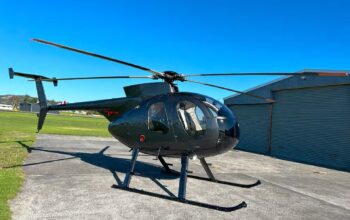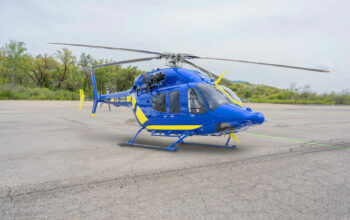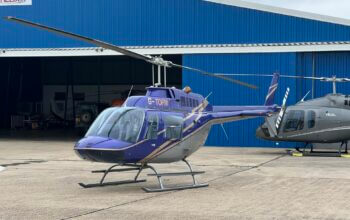Estimated reading time 9 minutes, 26 seconds.
According to research performed by the Transportation Safety Board of Canada (TSB), aviation accidents related to loss of visual reference are more than twice as likely to involve helicopters than airplanes.
It’s an issue the TSB has been highlighting for more than three decades.
Now, following the February release of its final investigation report on a fatal Nunavut helicopter crash in 2021, the board is calling for a multi-pronged approach that investigators believe would help commercial helicopter pilots survive inadvertent flight into instrument meteorological conditions (IIMC).
“Since 2010, the TSB has identified loss of spatial awareness in 14 investigations involving commercial helicopter flights, leading to the loss of 24 lives,” said TSB Chair Kathy Fox.
She explained that back in the 1990s, the TSB called for enhanced pilot training and the adoption of new technologies to help pilots safely recover after finding themselves in IIMC. The response? Instead of implementing these defences, Transport Canada’s (TC’s) current regulatory framework relies on the “avoid-at-all-costs” approach to prevent helicopter IIMC accidents.
“We’ve seen for decades that strong message stressing the importance of avoiding IIMC,” added Daryl Collins, senior air investigator at the TSB. “That’s very true, but you can’t intentionally plan to avoid something that you never planned to encounter in the first place. You can’t rely on that strategy. Pilots will inadvertently enter these situations. And, as we’ve seen, they need to have certain defences in place to recover.”
Collins was the lead TSB investigator into the April 25, 2021, crash of an Airbus Helicopters AS350 B2 operated by Great Slave Helicopters 2018 Ltd. The helicopter was carrying a pilot, an aircraft maintenance engineer, and a biologist when it crashed onto Griffin Island, Nunavut. No one survived.
The investigation found that the uniform snow-covered terrain, overcast sky and snow squalls likely created flat light and whiteout conditions. The pilot lost visual reference to the horizon and unintentionally descended while trying to maneuver the helicopter.
In its final report, the TSB issued four recommendations to Transport Canada:
- Train and maintain pilot skills: The regulator should require commercial helicopter operators to ensure their VFR (visual flight rules) pilots have the necessary skills to recover from inadvertent flight into IMC.
“This would include training on the conditions leading to IIMC as well as basic flight instrument flying skills,” said Fox. “Currently, there is no requirement for VFR helicopter pilots to demonstrate during annual proficiency checks that they could safely recover from an IIMC encounter.”
The Board is not recommending a specific amount of training; however, the Royal Canadian Air Force told the TSB that it would take perhaps a handful of hours, preferably done quarterly, to develop the necessary basic IIMC recovery skills.
- Tap into technology: Operators should be required to implement technology to help pilots identify, avoid, and recover from IIMC. Some examples include flight instruments necessary for instrument flight, radar altimeters, ground proximity warning systems (GPWS), and terrain avoidance and warning systems (TAWS). More advanced options include enhanced vision and synthetic vision systems.
“One of the greatest challenges of IIMC is that it’s insidious,” noted Collins. “It’s hard to identify the moment just before you lose visual references. The right technology, when used properly, can help warn a pilot that they may be approaching IIMC. If they do encounter IIMC, that technology can give them critical information they need to safely recover from it.”
- Develop SOPs: The TSB is recommending that all private and commercial operators who conduct single-pilot operations — whether airplane or helicopter — be required to develop standard operating procedures (SOPs) that can be used as a frame of reference to support pilot decision-making.
Explained Fox: “In Canada, when operating multi-crew, operators are required to have SOPs. That provides some pre-determined solutions to help crews address certain events. There is no such requirement for SOPs in single-pilot ops. Even in a single pilot setting, particularly with pilots who don’t have as much experience, SOPs can provide some pre-determined solutions.”
Collins added that a big benefit of SOPs is that they capture industry best practices for pilots and serve as a way to pass along corporate knowledge.
- Enhance reduced visibility regs: For helicopter operators who are approved to carry out reduced visibility operations in uncontrolled airspace, the TSB is recommending that the regulations be amended to ensure an equivalent level of safety compared to their fixed-wing counterparts. For example, airplanes with this approval can perform VFR operations in uncontrolled airspace — while operating at less than 1,000 feet AGL — to a minimum of one statute mile visibility. For helicopters in the same conditions, it’s half of that. And, while VFR airplane pilots are required to have certain flight instruments and basic annual and recurrent instrument training, helicopter pilots are not.
“There is a disconnect here,” said Fox. “There is not an equivalent level of safety. Helicopter pilots lack the same training, technology, and operating requirements as their fixed-wing counterparts. They should have similar defences in place.”
Fox — who spoke with Vertical from the annual Northern Air Transport Association conference in Yellowknife, Northwest Territories — said the Minister of Transport has 90 days to respond to the TSB recommendations, which were issued on Feb. 15, 2024.
“That brings us to mid-May,” she said. “Then, the TSB will take a month or two to assess the [regulator’s] response before we review and publish our assessment. We are optimistic that they will take action. We’ve seen the ‘avoid IIMC at all costs’ approach is not working, so they have to do something different.”
However, both Fox and Collins said operators don’t need to wait for the regulator to take steps to improve the safety of their operations.
“You can start now,” said Fox. “Be aware of the risk of VFR into IIMC. Provide pilot training and ensure skills are there now. You can also increase technology on board the helicopter.”
Collins added that the cost of technology is coming down, which makes the idea of incorporating better equipment more feasible.
“Operators recognize the benefit of these defences,” he said. “Some operators are fully committed to reducing IIMC accidents and are taking steps to do it. We’re even starting to see operators incorporating synthetic vision that you can run off an iPad.”
However, while some operators will voluntarily make these improvements, Fox also knows they are competing in a highly competitive business with other operators who won’t.
“When Transport Canada makes these things mandatory, it levels the playing field,” she concluded.


